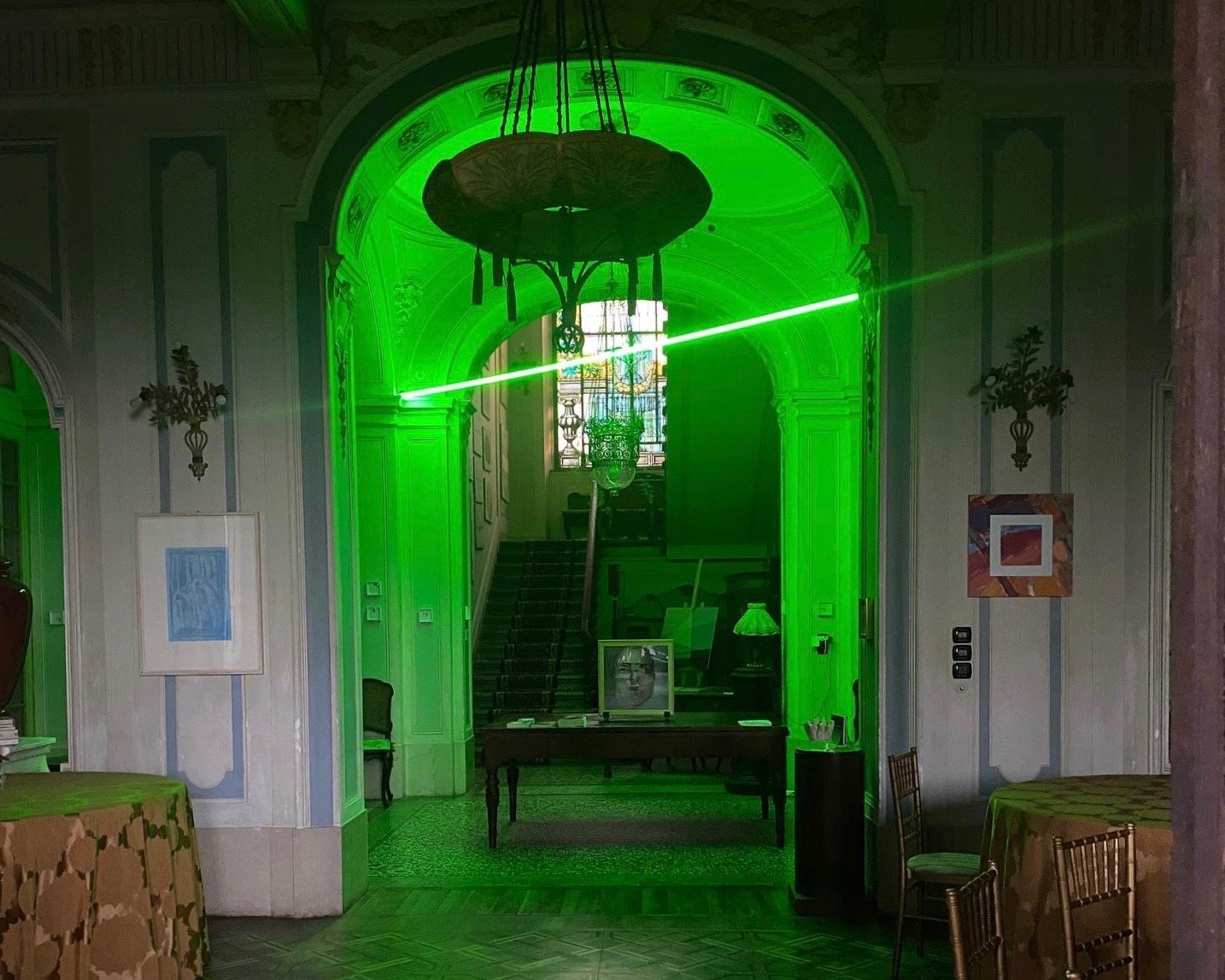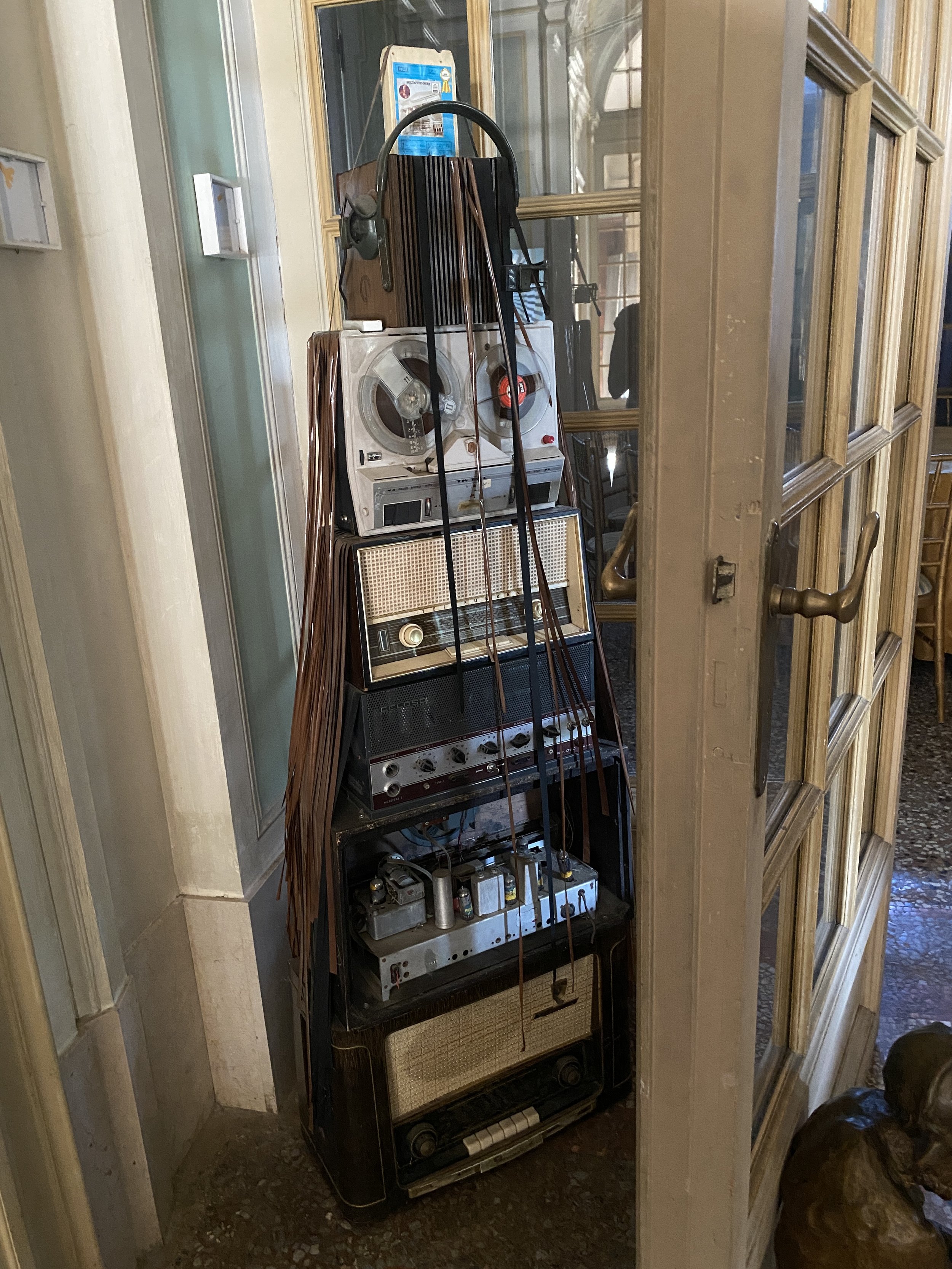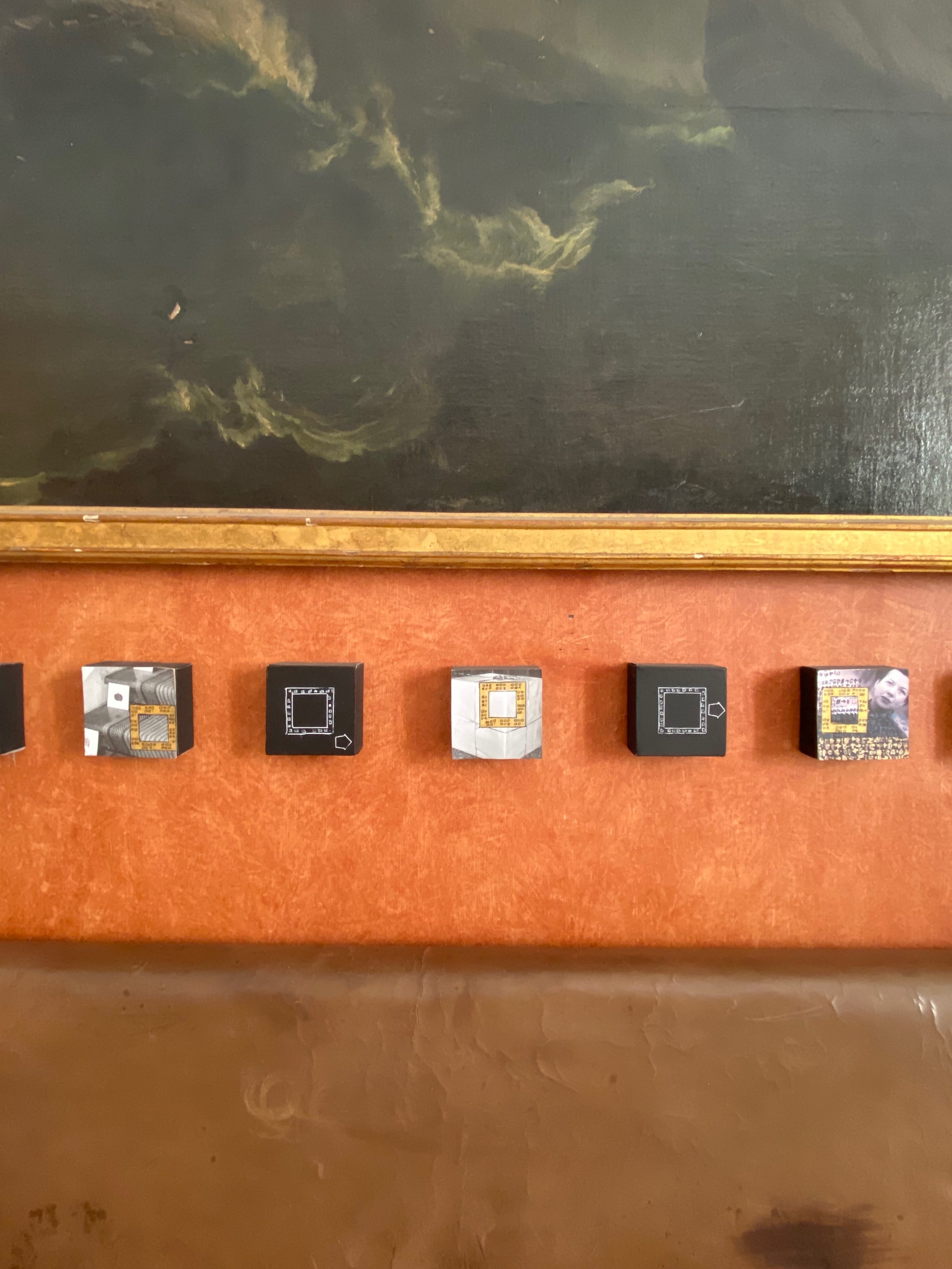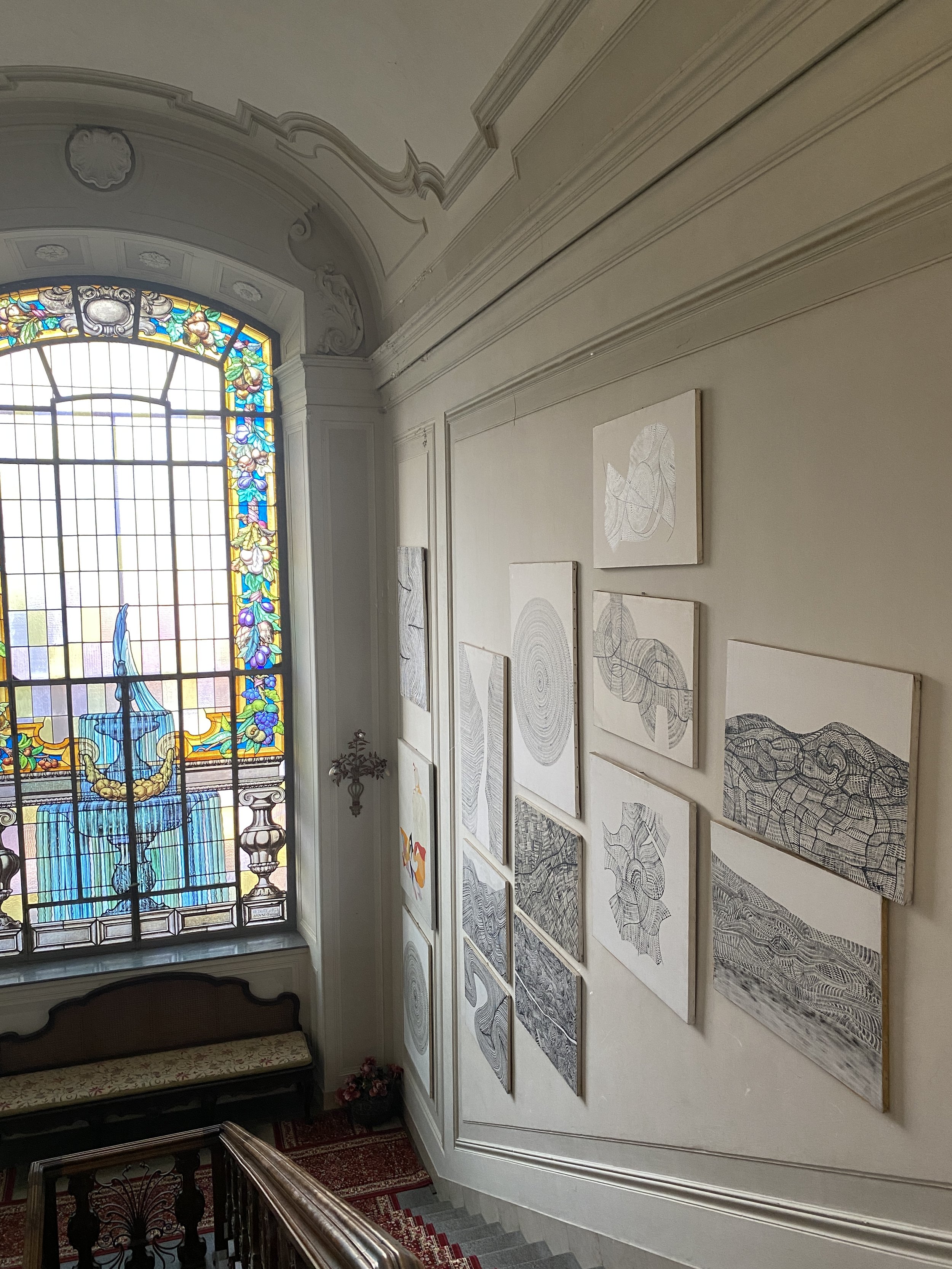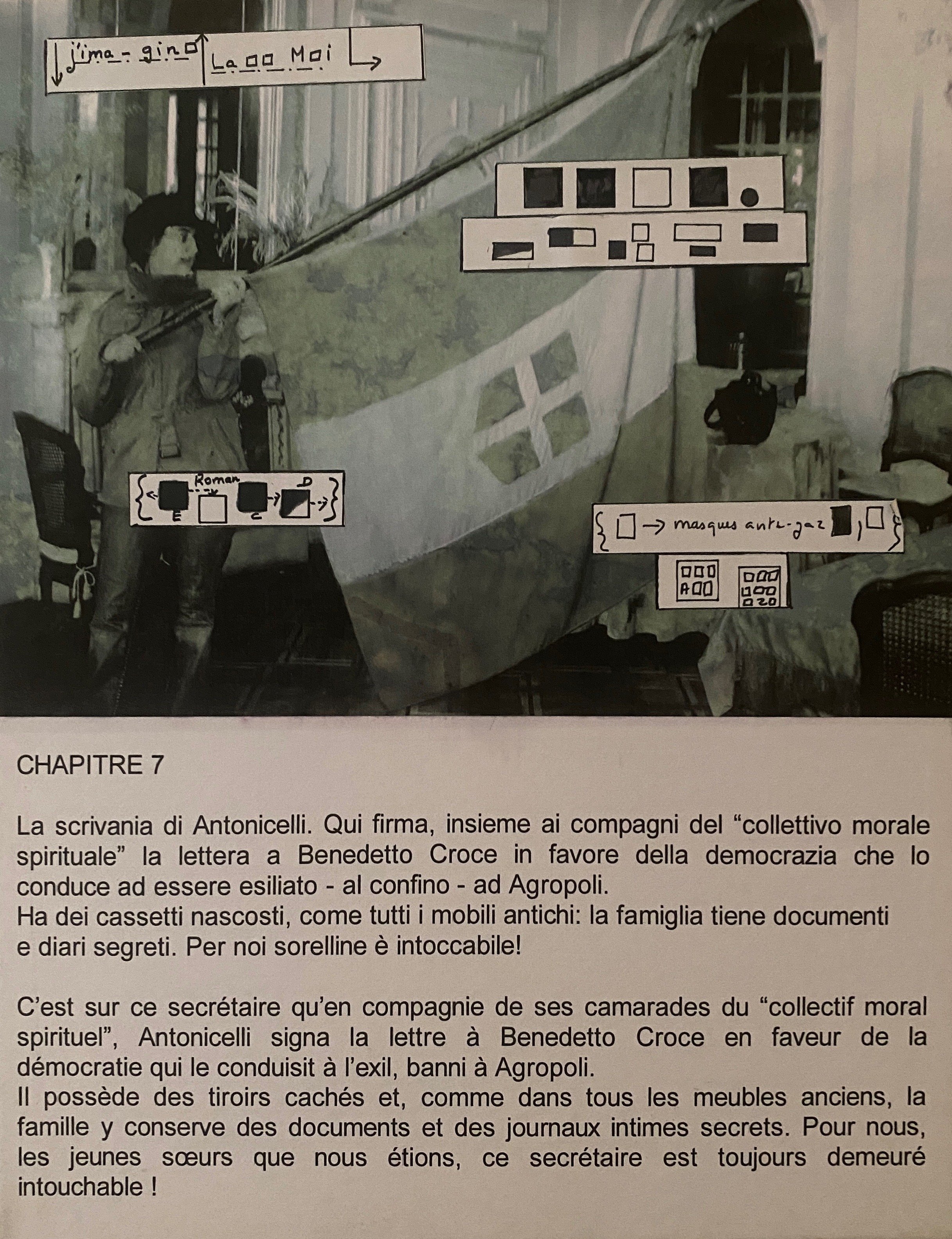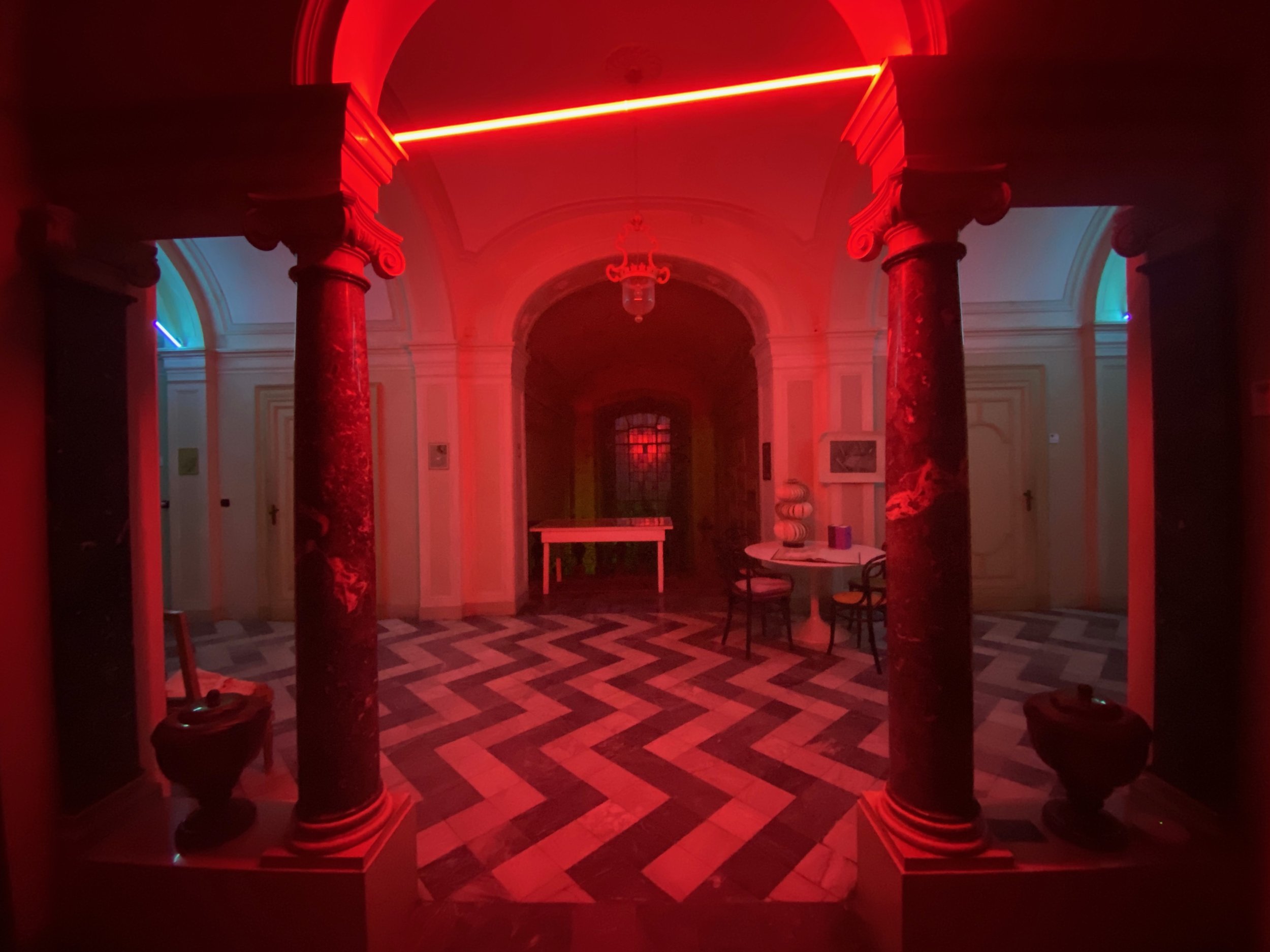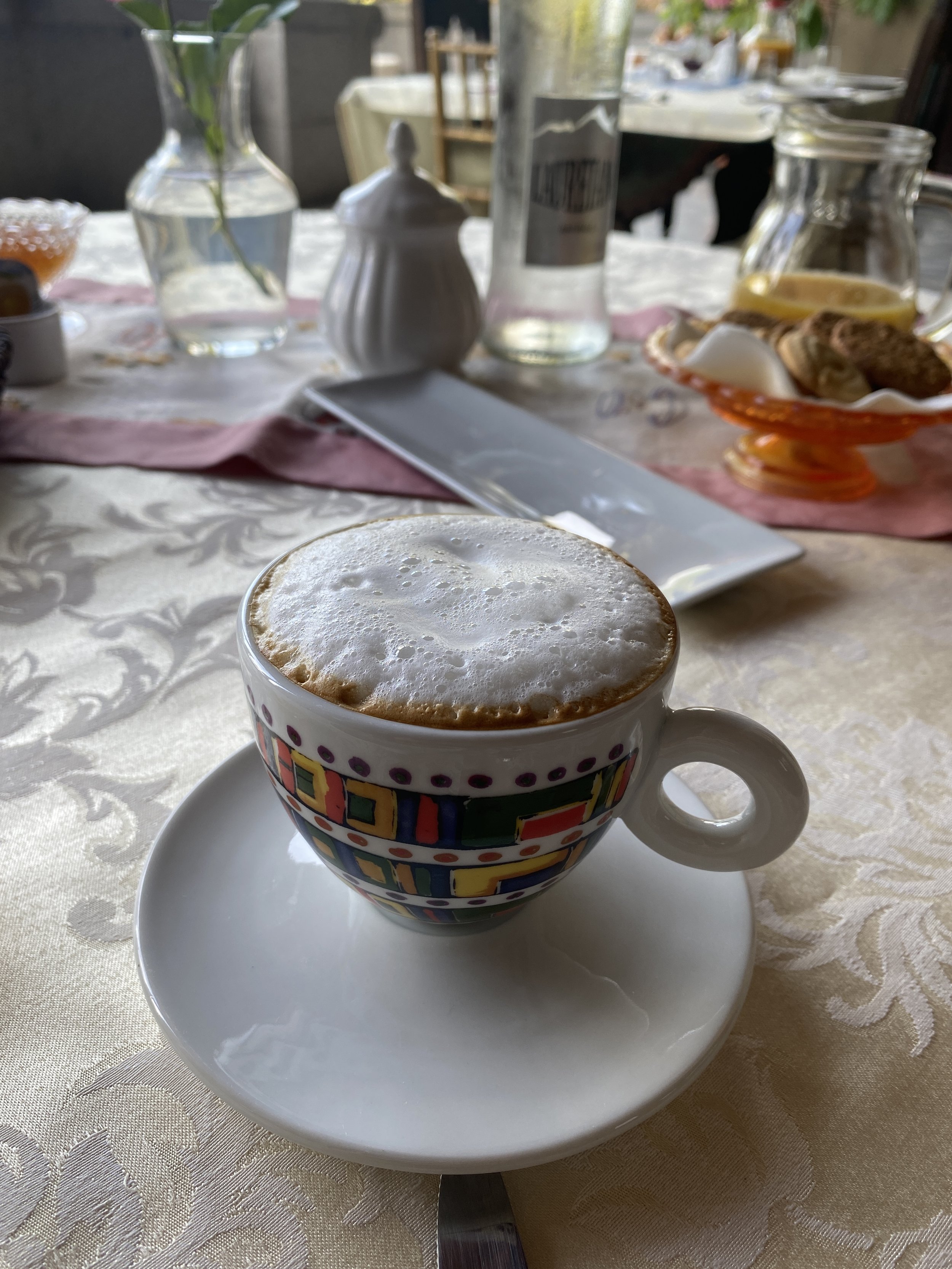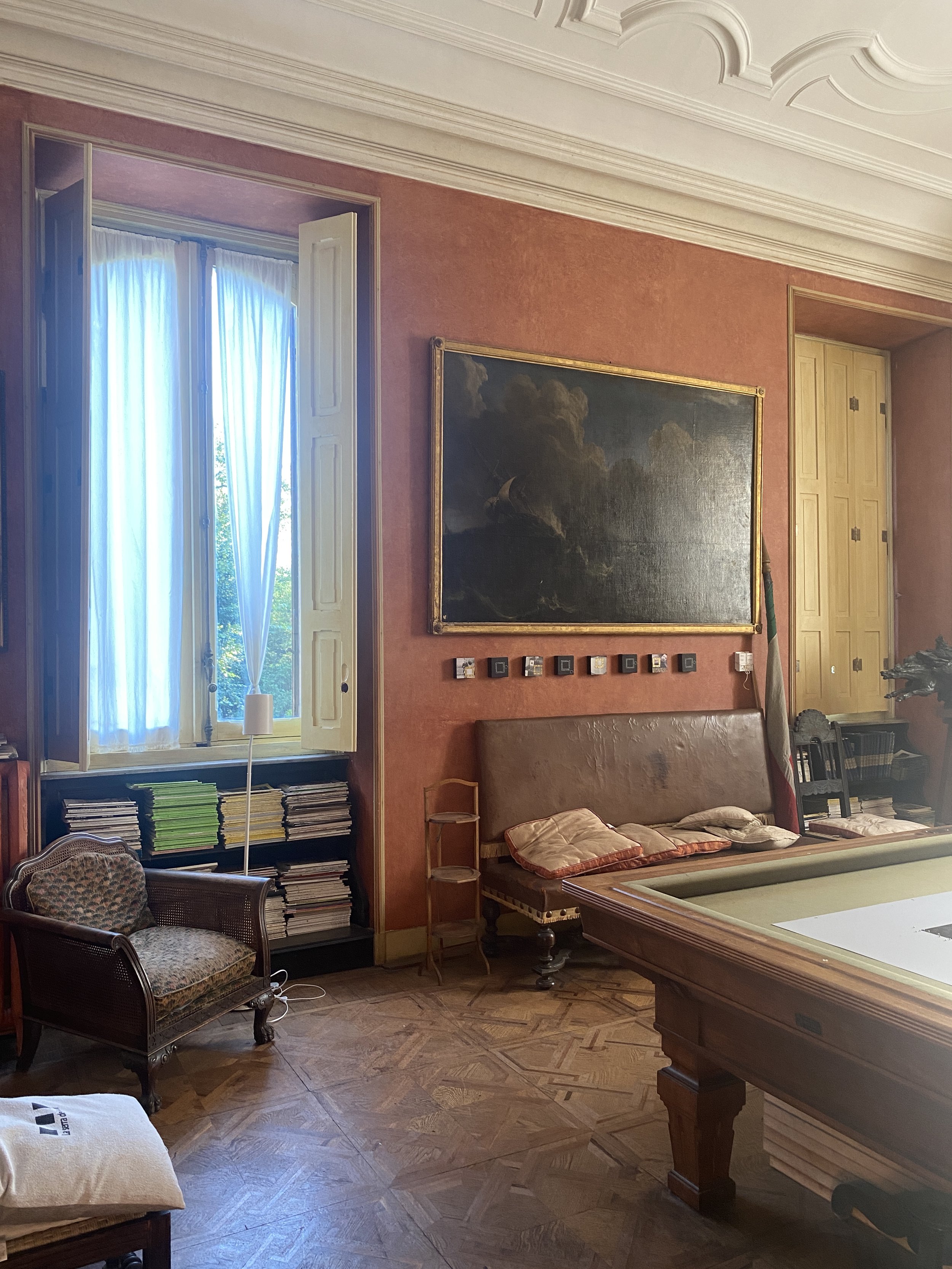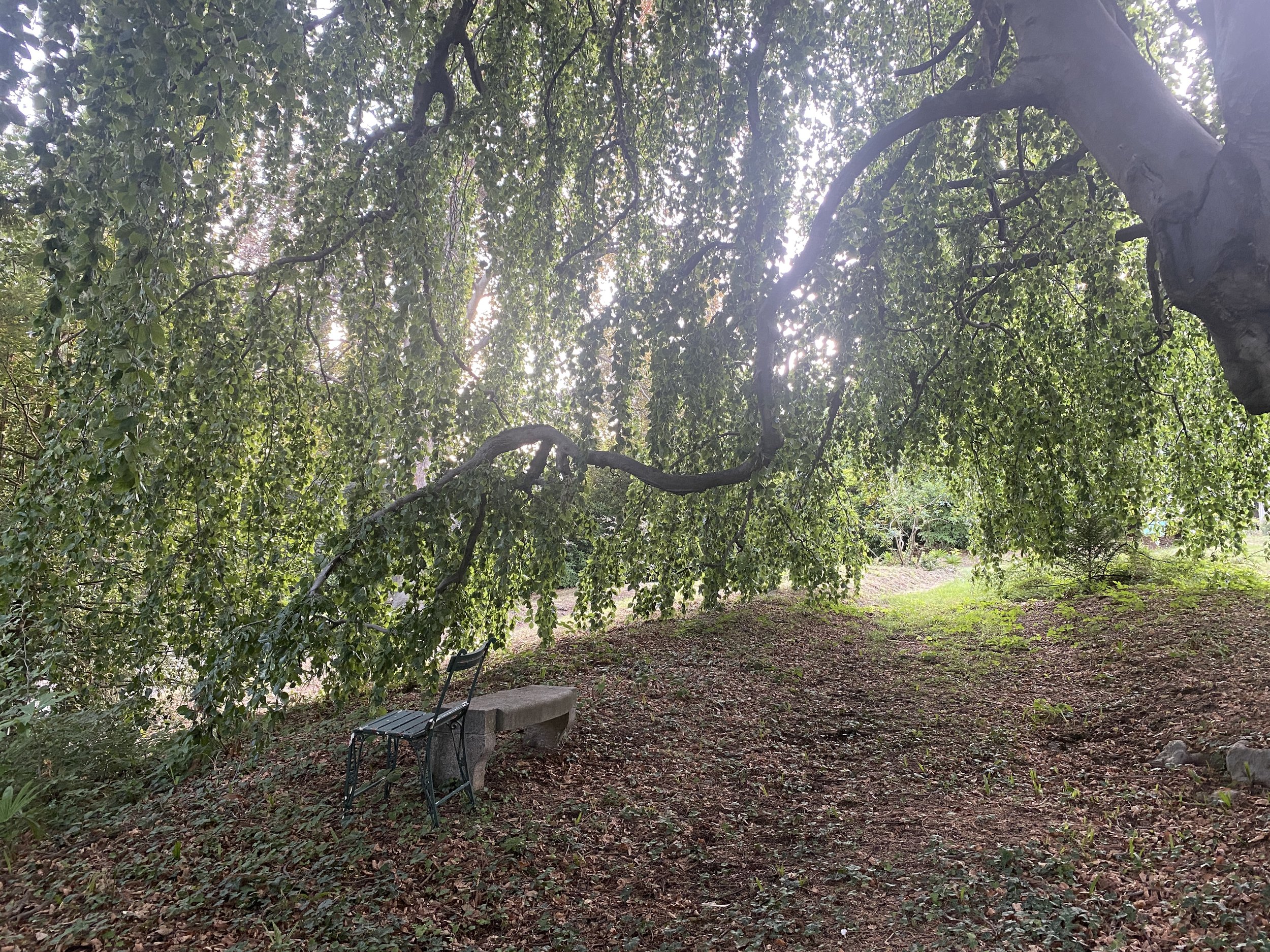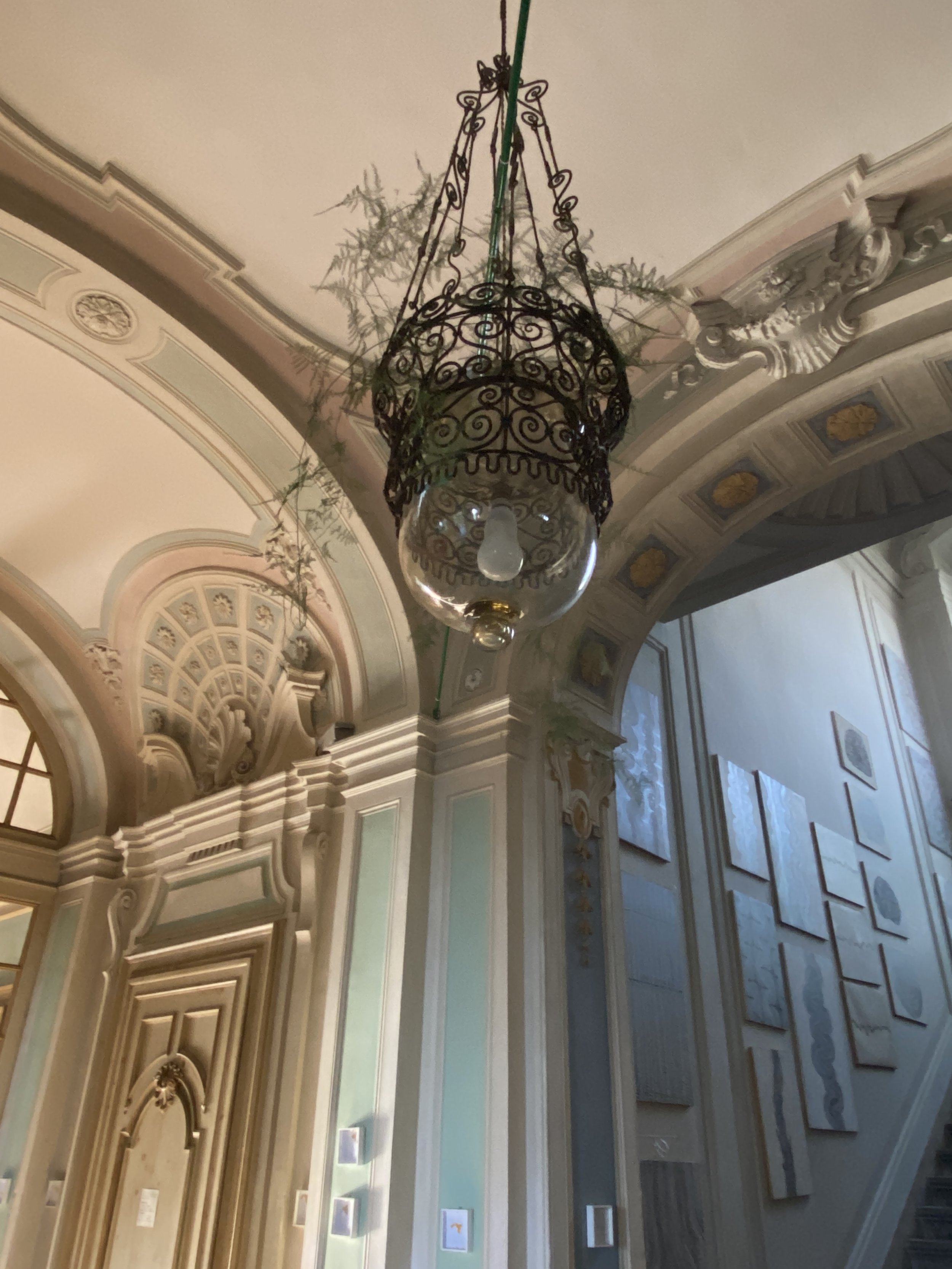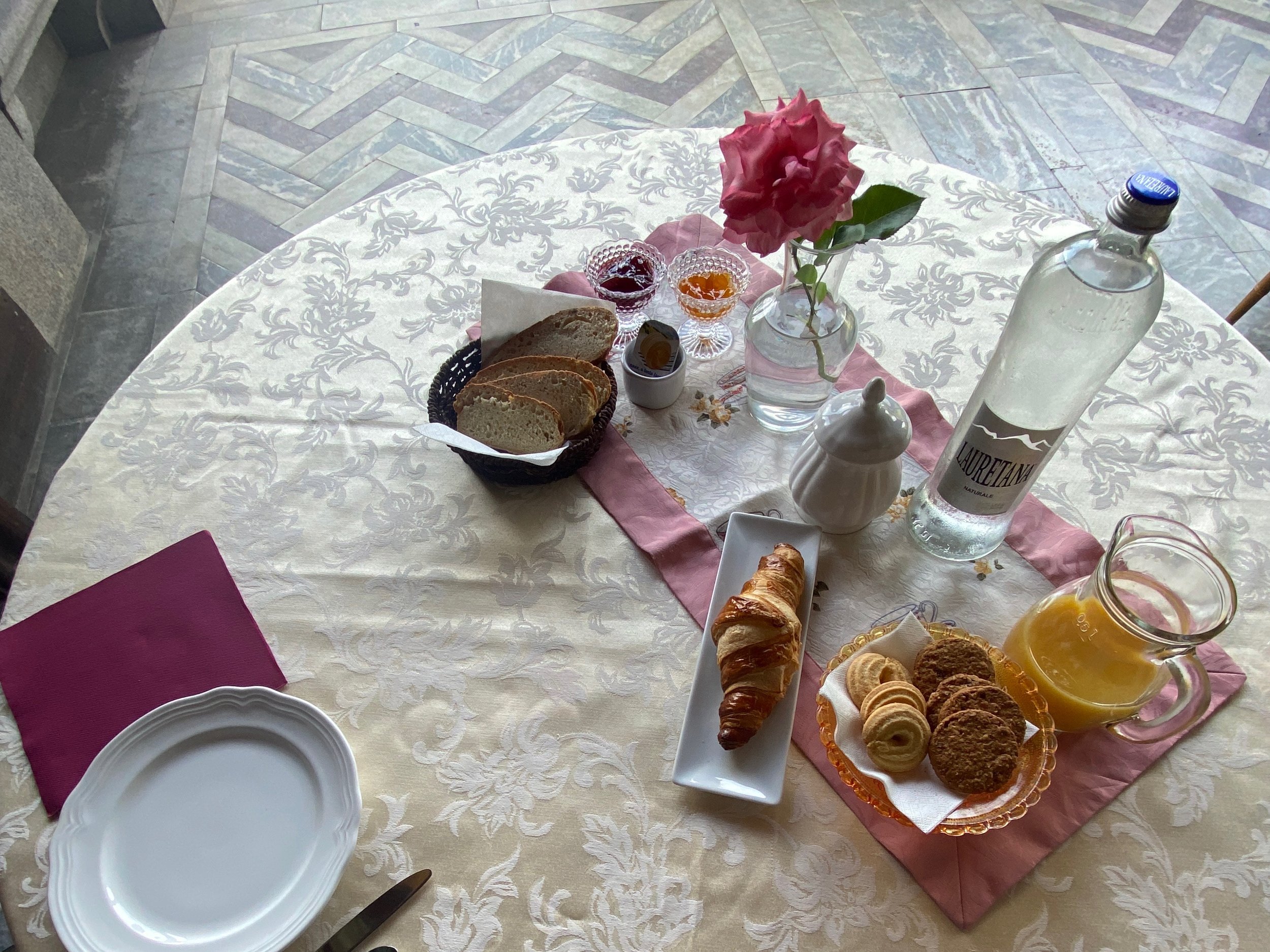Art Connections in Italy
FLUXUS ART AND MORE
Biella-based, Villa Cernigliaro, founded by Carlotta Cernigliaro, once was her childhood home and was first acquired by her father in 1949.
Now it is a charming and provocative art museum as well as a cozy Bed and Breakfast curated by Carlotta Cerngliaro. Below is a description of Carlotta’s mission statement written about Zero Gravity and the incentive of her collection. This experimental reality is quite a treat to encounter.
I share photos of my stay in July 2022. The villa houses a mixture of antiquities and contemporary art. Carlotta’s collection of avant-garde Fluxus Art (from the 1950s to the present) is poetic as well as moving. The daring and playfulness of each artist’s contribution bring a fresh sense of what art is and can be. My days in the villa were spent as a secret detective finding hidden treasures within the multi-layers of an eclectic mixture of art and design. I was floored at the daringness Carlotta possessed to design such an imaginative space filled with objects, paintings, drawings, clothes, games, maps, musical references, other permanent collections such as Chinese, Japanese and Italian prints/paintings and so much more within the confines of the 17th-century villa complete with original furniture mixed with modern.
The outside garden and orchard areas were equally fascinating, I pretended to be a child-like Carlotta once was growing up on such a massive and impressionable estate. I played with her dogs and pretended to be a queen in the labyrinth. I even spent hours choreographing a walk around Michelangelo Pistoletto’s “Third Paradise” also located on the property. My stay was incredibly memorable, I plan to return annually to learn a little bit more about Carlotta and her oeuvre for fascinating detail. Amongst discovering Fluxus works from Carlotta’s collection memorable works were Anne-Catherine Caron, “Roman Lettriste” (12 chapters) and (27 doors), Light and Space artist Pavel Korbiča’s night installation, and the incredible kindness and sharing of Friend of Fluxus Art, Paola Zorzi’s various mixed media artworks, consisting of sculpture, drawings, documents, paintings, and installation art.
After viewing the photo journal, please take a moment to enjoy the text about the story of the property before Carlotta’s time. The villa was a hideaway for particular individuals that would devise a plan that would change the history of Italy forever.
ADDRESS: Villa Cerniligaro, Via Clemente Vercellone, 4, 13817 Sordevolo BI, Italy
+39 015 256 2174, Province of Biella
Website: http://www.villacernigliaro.it Email: carlottacernigliaro@gmail.com
Villa Cernigliaro, Biella, Italy
Carlotta Cernigliaro and Lawrence Ferlinghetti, “Vuoi Fluxare con me?”
ZERO GRAVITY (created by Carlotta Cernigliaro)
VILLA CERNIGLIARO FOR ARTS AND CULTURES
Onlus Association
FREE CHOICE
2000 - 2022 - HISTORY OF A POSSIBLE UTOPIA
Zero Gravity is an anti-fragile non-profit experimental artistic reality that, moving autonomously and emancipated from the institutional system, has catalyzed a comparison between historical avant-gardes and new artistic trends.
The Association, committed to the perpetual redevelopment of Villa Cernigliaro, has transformed this Cultural Property into a historic home gallery of independent visionary resistance.
At the beginning of the last century and in the full Fascist regime, thanks to Franco Antonicelli, the Villa became a meeting place and a place for politically dissident thought of intellectuals such as Ginzburg, Levi, Pavese, Einaudi, Frassinelli, Bollati, Croce, Bobbio, Mila, Zini, Montale, Colonnetti, Monti, Tessa, and many others.
Today the mission consistent with Antonicelli's fil-rouge is to give voice, space, freedom, and support both to artists of the historical avant-gardes explored by the few and to researchers of deeper links between art and contemporary evolutionary languages. Guiding the selection is the need for experimentation and open exchange of artistic and curatorial practices and the desire to insert new artists in an imaginary confrontation with their immediate predecessors.
Villa Cernigliaro is today a museum that you live in, a home for pioneers of languages, a place where dialogue with contemporaneity is integrated into everyday life in a magical synergy that generates unprecedented projects immersed in a domestic atmosphere with a historical imprint. It welcomes and presents international cultural experiences, organizes and promotes collective and personal exhibitions of historical, emerging and mid-career artists, site-specific installations, research projects, concerts, and live performances, and co-produces high culture experimental operations in collaboration with artists, curators, art historians, collectors.
Villa Cernigliaro has collaborated with local public bodies but has become independent from the logic of cultural consumerism, from definitions of specific generational languages of contemporary art, from lobbies or elites, from power politics, from economic conditioning, with the aim of stimulating active and critical attention, open to exploration and inclusion. It is an international residence dedicated to particular to dissident artists and artists in their countries of origin. Inside there is a communication studio that historicizes, produces, and publishes books and art catalogs.
There is a Bookshop dedicated to the editions, some of which are exhibited at the Center Pompidou and the Palais de Tokyo in Paris.
Villa Cernigliaro remains a historic Antonicellian residence in Sordevolo, located in Biella, Italy, and is bound by the Ministry of Education and protected by the Superintendence for Architectural Heritage and Landscape of Piedmont in Turin.
ARTISTS on display
Marica Albertario, Valerio Anceschi, Giovanni Anceschi, Enrico Baj, Silvia Beccaria, Matteo Bernardini , Beniamino Bertoldo, Paola Bisio, Roberto Bottari, Breddo, Marina Buratti, Federico Buchicchio/Red, Carlo Carrà, Loriana Castano, Pietro Cernigliaro, Henri Chopin Collezione, Fabrizio Clerici, Maurizio Corona, Marina De Bellagente La Palma, Agneza Dorkie Collezione, Luisa Elia, Enotrio, Lawrence Ferlinghetti, Paolo Folino, Giovanni Franzi Collezione, Aurelio Gravina, Giorgio Maria Griffa, Ivana Haiek, Maria Ester Joao, Jana Kasalova, Alessandra Lanza, Franco Mazzucchelli, Migneco, Enzo Minarelli, Daria Modiano, Angelo Molinari, Andrea Mori, Ydetoshi Nagasawa, Arnaldo Pomdoro, Picasso, Cristiano Mattia Ricci, Armando Riva, Flavia Robinson De Rossi, Jan Samez, Anita Selinger, Fausta Squatriti, Valter Seren, Enzo Eric Toccaceli, Roberta Toscano, Alfredo Tosello, Marco Ulivieri Collezione, Tano Zancanaro, Paola Zorzi, Alessio Larocchi
The drive into Villa Cernigliaro
Green coming on, by Light and Space artist, Pavel Korbiča
Graph Poem Machine
Anne-Catherine Caron (posted on doors)
Anne-Catherine Caron (12 Chapters)
“Third Paradise” land sculpture by Michelangelo Pistoletto
Work by - Paola Zorzi
Work by - Paola Zorzi
Light and Space artist, Pavel Korbiča
Artwork by Roland Sabatier
My morning coffee
On the billiards table work by Alessio Larocchi
Inside my room
Another view of my bedroom
Work in black by Paola Zorzi and object d’art in white by Alessio Larocchi
Morning breakfast
A view outside of the cafe
Introduction to Fluxus
“Fluxus was an avant-garde art movement that emerged in the late 1950s as a group of artists who had become disenchanted with the elitist attitude they perceived in the art world at the time. Like the Futurists and Dadaists before them, Fluxus artists did not agree with the authority of museums to determine the value of art, nor did they believe that one must be educated to view and understand a piece of art. Fluxus not only wanted art to be available to the masses, they also wanted everyone to produce art all the time. It is often difficult to define Fluxus, as many Fluxus artists claim that the act of defining the movement is, in fact, too limiting and reductive.” - The Art Story
PERMANENT COLLECTION
Villa Cernigliaro exhibits a collection of more than 200 works purchased by Carlotta Cernigliaro from 2000 to 2022 or donated by the artists she represented. The exhibition project shows an 'other' register of reading that returns the visitor to a place pierced by the artistic complexity of the contemporary and where different eras interact. The collection also includes paintings and decorative arts of the early twentieth century, ancient reproductions of geographical maps, a collection of Chinese and Japanese vintage prints, photos and drawings by Franco Antonicelli, the Gaetano Kanizsa Collection, numerous works by artists of post-war artistic movements and avant-gardes, such as Nagasawa, Lawrence Ferlinghetti, Henry Chopin, Jack Hirshman, and the Little Letters collection.
POETS
Antonella Anedda - Raffaello Baldini - Dario Capello - Gabriella Cinti - Maurizio Cucchi - Milo De Angelis - Agneta Falk - Umberto Fiori - Lawrence Ferlinghetti - Jack Hirsmann - Vivianne Lamarque - Claudio Lolli - Elio Pecora - Umberto Piersanti - Paul Polansky - Giovanna Sicari - Arrigo Lora Totino
CURATORIAL SYNERGY
Giovanni Anceschi - Mino Bertoldo - Francesco Conz - Milo De Angelis - Caterina Gualco - Miroslava Hàjek - Elisabetta Longari - Patrizia Maggia - Nicoletta Pallini
THE FASCINATING PRE-HISTORY OF VILLA CERNIGLIARO
WHEN IT WAS VILLA DELLE PUNTE
Reproduction and manual photo editing of the snapshots, taken by Antonicelli, edited by Luciana Mulas kindly granted by Patrizia Antonicelli.
The Villa delle Punte
Built in the 1880s, in Liberty style, commissioned by the Vercellone family, it was later acquired by the Turin notary.
Annibale Germano and later around 1945 by the Sicilian notary Carmelo Cernigliaro.
In the 1920s it was revisited by the architect Giovanni Chevalley who brought that eighteenth-century suggestion that can still be tasted today.
Villa Cernigliaro, the historic Antonicellian residence of Sordevolo, in the Biella area, is bound by the Ministry of Education and protected by the Superintendence for Architectural Heritage and Landscape of Piedmont in Turin. At the beginning of the last century and in the full Fascist regime, thanks to Franco Antonicelli, the Villa became a meeting place and a place for politically dissident intellectuals such as Ginzburg, Bobbio, Pavese, Einaudi, Frassinelli, Croce, Mila, Zini, Pirandello, Montale, Colonnetti, Frassati, Linati, Levi, Tessa, and many others.
Sordevolo's "buen retiro" in the years of fascism
“The impotent anger at the conditions, above all moral, in which Mussolini kept the Italians, grew and pushed me towards a group of young people who tried to react to these conditions. Being of a reflective temperament and anything but enthusiastic - indeed I was suffering from pathological shyness at the time - I was well aware that our efforts to stir up the leaden atmosphere in which he stagnated were doomed to fail in general apathy, but I seemed to have to act like this in order not to be ashamed of myself ". This is how Luigi Grosso expressed himself in an autobiographical memoir, recalling the Milanese years from 1930 to 1940, and his story, similar to that of other sculptors, can illuminate the condition of all those intellectuals who did not intend to accept, Italy in the 1920s. and Trenta, the dictatorship of fascism; it is an interesting testimony as it captures an important aspect of the anti-fascist struggle and finds correspondence in some notations by Franco Antonicelli.
"Anti-fascism was not just a series of political actions or coups d'etat; for a long time it was a little visible but existing bulwark of conscience, which made it difficult for the regime to sink and extend its roots ", a" - collective - spiritual and moral that kept alive - another Italy - alongside the official one ".
In Turin, this "other Italy", as a - spiritual and moral collective - which tends to constitute itself as a - bulwark of conscience -, has as active centers of resistance and opposition the factories and the university attended by those young people who at school they had been educated by teachers such as Umberto Cosmo and Augusto Monti, and now they drew on the word and example of teachers such as Gioele Solari, Francesco Ruffini, Lionello Venturi.
Antonicelli was a pupil of Umberto Cosmo and attended Augusto Monti, both professors at the Liceo d'Azeglio in Turin, and right around Monti, starting from 1928, a "spiritual and moral collective" was formed, a group in which Leone Ginzburg, Norberto Bobbio took part, Cesare Pavese, Massimo Mila, Sturani and Antonicelli himself; The meeting place was the Rattazzi café and as Bobbio recalls: "Monti ... moved the threads of the conversation, which was not necessarily political .
Rattazzi's lesson consisted, at least for me, is letting me touch the gap between the academic culture that is forged in the schools, and the militant one, which is formed between comrades and teachers who have come down from the professorship ... in protecting us all from illness of haughtiness ".
Here is Monti's lesson: the practice of freedom against the "sickness of haughtiness", and similar was the lesson of Cosmo, "a man raised in freedom", who, was dismissed in 1926 from the chair of Italian literature at d'Azeglio for a generic incompatibility between his thinking and that of the regime, he expressed himself as follows: "... I wish the man who will rise to the chair from which I am forced to descend to bring to it the freedom and dignity with which I 'I have been busy for many years ”.
All these names appear in the gallery of the characters photographed by Antonicelli and it was thanks to Antonicelli that this "spiritual and moral collective" could be reconstituted every summer, starting from 1935, in Sordevolo in the villa of Annibale Germano, Antonicelli's father-in-law:
"There was a time, difficult to forget, when a small group of trusted friends found themselves with the most spontaneous pleasure to free the soul from the hateful weight of suspicion, prudent silence, worries and sudden dangers. ... The time I am referring to was that of Fascism."
The group was the one that was usually rebuilt every summer in the Biella area, in Sordevolo and Pollone. There were two main meeting places: the villa inhabited, I believe since 1934, by Benedetto Croce in Pollone, and the villa which had been owned by Annibale Germano in Sordevolo for much longer. The first was the destination of illustrious visits, the second no less, partly as a reflection or appendage of the first. Of the second I can say that ... everyone ... could speak freely, even if tied with some ties to the regime; however, true confidence in politics was restricted to a few regulars.
All of them: Simoni, Pastonchi, Bontempelli, Linati, Tessa, Gadda, Conti, Della Corte, Bernardelli, Quadrone, Cosmo, Falco, Salvatorelli; the few: Gustavo Colonnetti stood out. Other names appear, Cosmo's reappears, characters linked together by a "communion of consciences", a bond that Antonicelli sees in some way symbolized by the road that connects Pollone to Sordevolo: "Topographically, the panoramic winding road between the two villages can mark the link between the members of the group ".
by Franco Antonicelli, Gallery of symbols, Ed. Zero Gravità 1999, 1st Edition
Texts by Marzia and Raffaella Barberis
Franco Antonicelli
Studious, critic, poet, essayist, publisher, orator, a politician in the broadest sense of the term, that is to say, a casual guide of every conversation, but also a man of action capable of risky interventions in the heart of civil affairs; and a wonderful conversationalist for the extension of his voice - from the tones of rigor and indignation to the inventions of unattainable humor; Franco Antonicelli was also a photographer and designer. It was necessary to have known him well to know that all the figures he personified, apparently so distant from each other, were composed in the unity of a single, unrepeatable, sovereign character. He was one of the few capable "of defending his own nature" - as Giaime Pintor asked - and therefore of existing and having weight in an age that erases the personality under the labels and behind the gates of preordained schemes. Faithful to himself and to his origins, he freely ran the risk of dispersion, living the adventure, rich in noble cultural ancestry, of the one who "loves what he does" - as Burckhardt says of the great amateur -, and who therefore does what no surprise, therefore, that he postponed the complete expression of himself to "after", not because he was distracted by a flower or a swallow (or perhaps even), but because he was urgently busy with the tasks of historical relevance that fulfilled "always well, but most of the time at the request of others, only by my fervent (and sometimes annoyed) consent; rarely by my election (except political actions)" - as he left written with a sincerity of which the caustics of perfect commitment should treasure. Franco Antonicelli loved everything and would have liked to do everything. He tended to an "integral humanity" and sought it in public and private life. But there were priorities to be respected etc: prison, confinement, a stormy rally against the Tambroni government, and the struggles of the workers of Turin, Genoa, and Livorno, came before anything else. An essay on Villon, the scent of Lantana Camara (Mediterranean flower), had to wait. But in the meantime he was taking notes, accumulating notes, and his work table disappeared under the notes of an interminable preparation. They were notes of all kinds, diaries, hasty annotations, epigrams, photographs, and drawings. The "work" would be born from that accumulation of notes. But in them, the curiosity, the intelligence, and the gaze of Franco Antonicelli were expressed, and for a moment satisfied. If it were also the look and hand of an artist, others will say. Franco Antonicelli was able to fix the fugitive frames of life, moved by an impulse in which the man of letters, the esthete, the moralist, the historian, always assisted by the man of mind. - Giulio Bollati
Those who visited and made it their secret getaway
Pavese, Ginzburg, Antonicelli, and the publisher Frassinelli in San Grato, Sordevolo 1932
Thus Corrado Stajano: "Frassinelli is the typographer in shirt sleeves and suspenders, with an attentive and serious look, ... with Pavese who looks like a disgruntled immigrant, Ginzburg, with a notebook in hand that recalls the doctor in some of Chekhov's comedies, Elegant Antonicelli, with a brand new hat with a high ribbon, the bust and legs in a perfect pose, like the crease of the trousers.
Franco Antonicelli at the desk,
September 4, 1936
The stay in Biella gave Antonicelli the opportunity to cultivate the reading and study of the most loved authors with a tranquility that recalled his youth. For Dante, the stilnovists and the classics Antonicelli nurtured an absolute passion because "they are living life, real reality, always fresh, always accessible".
Thus Antonicelli wrote on the desk of his deaf house: "only the interior can give us that richer sense of life that we call happiness. In fact, it is only in progress that we feel our life enriched and gladdened and only in the fervor of the interior life do we recognize progress ”.
Andrea Della Corte with Zino Zini, in the Italian Garden
When the Sordevolo house was open to guests, between the end of the 1920s and the beginning of the 1930s, Andrea della Corte became a regular guest: a well-known musicologist of Neapolitan origin, a teacher in Turin at the Conservatory and later at the University . With these words he remembers Maestro Toscanini: «Music always. He lately held her close, in a jealous embrace of love, trembling in remembrance, terrified of forgetting. Abolished the terms of day and night, greedy, alert, perplexed, he listened to the engravings, his last vitality, our precious inheritance, and each time he discovered better the deep substance, the secret entity of the lovingly known work of art. .. Sometimes listening to himself he deplored: “I have never directed this piece well”, he was mortified, as if by an inability, which neither study nor affection had been able to mitigate ». Franco Antonicelli, Reading calendar
Umberto Cosmo
Among the various personalities who frequented Villa Germano di Sordevolo, Antonicelli remembers Umberto Cosmo, a teacher of Italian literature at the Liceo d'Azeglio in Turin, who resigned from teaching in 1926 following the accusation, formulated by the Minister of Education Pietro Fedele, of "Incompatibility" between personal thought and the general directives of the regime. He was imprisoned in 1929 and sentenced to one year of confinement for having signed the letter of solidarity to Croce, who intervened against the Concordat between the State and the Holy See and defined by Mussolini as "the ambush of history".
Zino Zini
Bobbio writes: "Neither Cosmo nor Zini spoke to us about politics ... but their presence was in itself a warning, a living denial to the insolence that was thrown up every day on the opponents ... and an invitation not to linger in conformity , not to let ourselves be lured by propaganda.
Zino Zini, a socialist teacher of history and philosophy at the Liceo d’Azeglio, had sided with the Communist group as a city councilor in Turin and had collaborated with the New Order. In 1921, a philosophical pamphlet appeared, The Congress of the Dead, a pacifist protest against the uselessness of wars: in the valley of Josaphat, victims and executioners gather to discuss the responsibility for millions of massacres. Alexander the Great, Attila, Napoleon: all justify their conduct in front of Christ, but the only one to have acted according to morality was a Roman soldier, the legionary of Lambessa who, against war and prevarication, professes his submission to Christ. Zini as a teacher of non-conformism and morality: Antonicelli remembers him as a "writer and philosopher, or rather a moralist, who was a teacher to many generations of schoolchildren".
Augusto Monti
Professor of Italian at the Liceo d’Azeglio from 1923 to 1932, he became the "prof" for some high school alumni, an older friend and companion from whom to learn life lessons.
“When I read Monti it is as if I continue to listen to him. Behind every word there is the living character whose voice we had been enchanted so many times, severe, tolerant but not accommodating, who seemed gloomy and also knew how to be hilarious, and had the pleasure of telling the facts with an easy-going, at times almost jaunty air. and at the same time to give without opinion the lesson that had to be drawn from it, and it was always a lesson of seriousness, of respect for others through respect for oneself, firmness, dignity ... There were really those who, sick, he would get out of bed so as not to miss the hour in which Monti explained and read Dante's weekly canto. A lesson of which one of his pupils ..., Carlo Mussa Ivaldi, wondering what the secret was, replies that this secret was knowing how to translate literary values into interior and civil values ».
This writes Norberto Bobbio remembering Augusto Monti.





